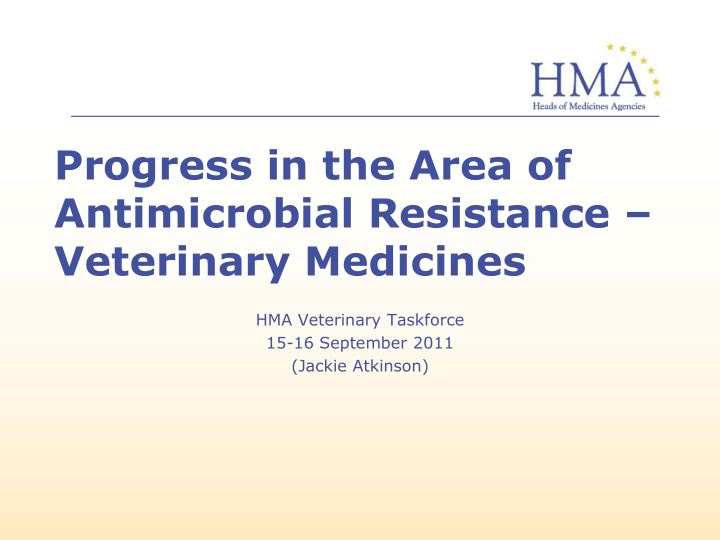



Progress in the Area of Antimicrobial Resistance – Veterinary Medicines HMA Veterinary Taskforce 15-16 September 2011 (Jackie Atkinson)
Overview • The last 18 months • The next 18 months (priority areas) • Collaboration
Background 1 • HMA MG decision in July 2008 to develop a strategy • HMA veterinary Strategy on Antimicrobial Issues agreed by HMA June 2010 • Publication delayed until December 2010 http://www.hma.eu/uploads/media/H MA_AMR_Action_Plan_Feb_2011.pdf
Background 2 • HMA veterinary taskforce formed Dec 2010 to finalise action plan and to oversee its delivery • Action Plan published February 2011 http://www.hma.eu/283.html
HMA Strategy - Vision • Maintaining efficacy and minimising the development of resistance one of the most important tasks • Measures should be balanced so availability is not unreasonably compromised • Focus should be prudent and responsible use – essential tool • Communication and international dimensions key
Taskforce Composition UK as chair and secretariat • EMA • NCAs • – Czech Republic – France – Hungary – Germany – Ireland – Romania – Spain – Sweden – The Netherlands
Stakeholder Identification Active (HMAv taskforce will seek to Involved (HMAv taskforce will seek engage these groups in delivering their to influence these groups but only strategy and involve them in any focus at specific times) group meeting) CMOs AVC, COPA-COGECA, CRL for AMR MEPs (but will vary) CVOs, EC, ECDC EAVPT EFSA, EMA, ESVAC FVE, IFAH, TATFAMR EGGVP, EPRUMA EURL AMR Dormant (no HMAv Taskforce Aware (no HMAv taskforce activity activity planned) planned but can expect interest from FEEDM these groups and updates on work will be provided if requested) APUA, Codex FAO, OIE WHO, BEUC PGEU Key Human – Blue Veterinary – Green Joint – Red
Mapping of Current Activities • Template created (responsibilities, collection of sales data/prescription data, factors affecting prescribing, advertising rules, surveillance, responsible use guidance, communication, national restrictions on use, targets to reduce use) • Summarising NCA activities • Responses from 25 (+) NCAs • Consolidated responses • Overview of responses
Key Points 1 • NCAs have a range of responsibilities (authorisations, pharmacovigilance common areas) • Most NCAs already engaged in sales data collection • Only two NCAs have established systems for collection of information on prescriptions
Key Points 2 • Varying national rules on advertising (different restrictions on target audiences) • Scope on surveillance activities differ, most only engaged in meeting statutory obligations e.g. salmonella and campylobacter • Overall impression – NCAs already engaged or becoming more so with a number of national initiatives
National Restrictions on use of Antimicrobials (examples 1) • Czech Republic : If there is a restriction for a product then it may only be used if no product without such a restriction and only after sensitivity testing • Denmark: Issue “yellow cards” (fine + required corrective action) to farmers where use exceeds thresholds compared to average use
National Restrictions on use of Antimicrobials (examples 2) • Finland : Certain substances limited to exceptional conditions or prohibited • Sweden : Vet must consider risk of antimicrobial resistance when prescribing...........
Government Targets – France - a target has been set to reduce antimicrobial usage by 25% over 5 years. – The Netherlands - Dutch Minister of Agriculture stated last year that in 2011 a reduction of 20% should be realised as compared to 2009. In 2013 the reduction should be 50%.
How to use this information? • Publish overview document • Hope to publish a document setting out the surveillance landscape across the network (who does what and where can you find out more) • Will the Commission use some of the information when developing their plans for the legislation?
Revised EU Legislation – wish list 1 • The development of elements of veterinary medicines legislation, medicated feed legislation and animal health law relating to antimicrobials are progressed in a co-ordinated way , with the overall impact assessment being considered. The development of AM products containing new • antimicrobials and the development of new more convenient dosage forms for “established” antimicrobials which remain effective should be encouraged as long as any risks to public health related to their development and use in animals could be adequately managed.
Revised EU Legislation – wish list 2 – Legal base for annual collection of sales data by NCAs and forwarding to central point – Restrictions must take account of “One Health”, the need for medicines for animals, should be targeted and evidence based, feasible and enforceable – Introduce restrictions to the advertising of AMs, so that no advert can promote an AM on the basis of factors which are not consistent with responsible use.
Current Activities • EU wide survey of vets on prescribing habits and factors which influence these • Questionnaire design phase ( learning from a national survey conducted in Czech Republic ) • Logistics being explored
Next Steps/Priorities • Publish a report from this meeting • Adopt and publish the updated HMA action plan on antimicrobial issues in light of comments from IFAH and EPRUMA ( November 2011 HMA meeting ) • Develop an understanding of how different factors affect prescribing practices and consider how this information can be used
Next Steps/Priorities cont. • Communications – develop communication packs for different target audiences (e.g. MEPs, vets) • Consider and react to legislative proposals which impact on antimicrobials
Collaboration - existing • EMA • CVMP
Collaboration – possibilities (stakeholder responses) • IFAH – surveillance (target animal pathogens) • EPRUMA – communication on responsible use to a wide range of stakeholders • COPA-COGECA - communication on responsible use to farmers
Further collaboration possibilities Suggestions welcome Any suggestions or questions?
Recommend
More recommend